技巧
1.当你需要创造一条新链表的时候,可以使用虚拟头结点简化边界情况的处理。使用虚拟头节点时,注意题目要求,返回时一般要head.next。跟双指针同时使用时,返回新链表的一定是head.next,而不是p.next!!!因为这个会动的指针最后已经不知道知道哪里去了,犯了一百遍的错误。
2.递归的思想相对迭代思想。不要跳进递归,而是利用明确的定义来实现算法逻辑。递归操作链表并不高效。和迭代解法相比,虽然时间复杂度都是 O(N),但是迭代解法的空间复杂度是 O(1),而递归解法需要堆栈,空间复杂度是 O(N)。
3.链表是一种兼具递归和迭代性质的数据结构,认真思考一下可以发现这个问题具有递归性质。
4.双指针。对于单链表来说,大部分技巧都属于快慢指针。
题目
1.合并两个有序链表
简单
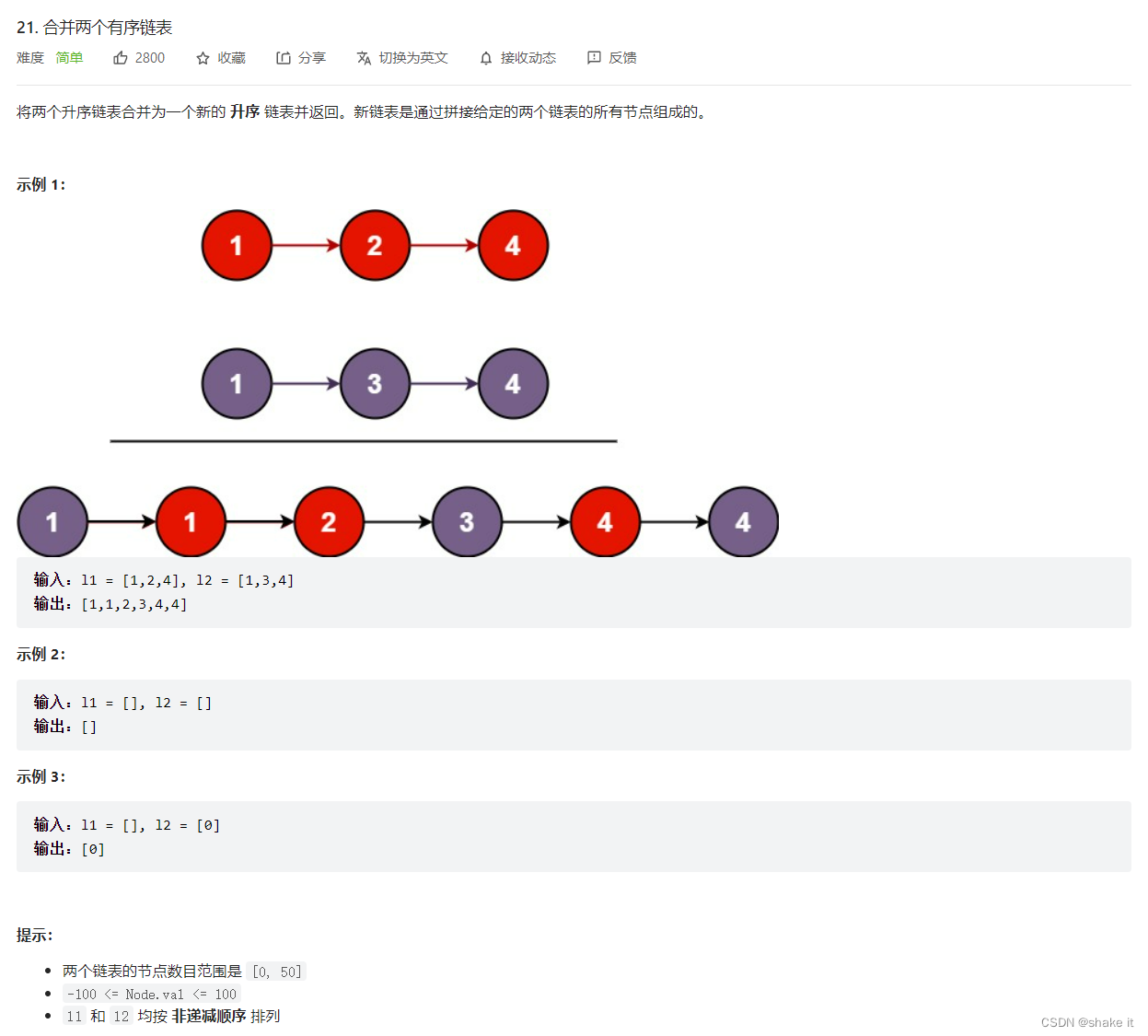
思路:
输入两个有序链表,把他俩合并成一个新的有序链表。双指针分别指向两个链表,依次比较两个指针指向的值的大小,值比较小的连接到新链表上,同时将该指针往后移一位。循环往复,直到一个或两个链表遍历完毕。并将未遍历完的链表的剩余部分直接拼在新链表上。
/**
* Definition for singly-linked list.
* function ListNode(val, next) {
* this.val = (val===undefined ? 0 : val)
* this.next = (next===undefined ? null : next)
* }
*/
/**
* @param {ListNode} list1
* @param {ListNode} list2
* @return {ListNode}
*/
var mergeTwoLists = function(list1, list2) {
let ret = new ListNode(0,null);
let p1= list1, p2 = list2, cur = ret;
while(p1&&p2){
if(p1.val<p2.val){
cur.next = p1;
p1 = p1.next;
}
else{
cur.next = p2;
p2 = p2.next;
}
cur = cur.next;
}
if(p1==null){
cur.next = p2;
}
if(p2==null){
cur.next = p1;
}
return ret.next;
};
2.单链表的分解
中等
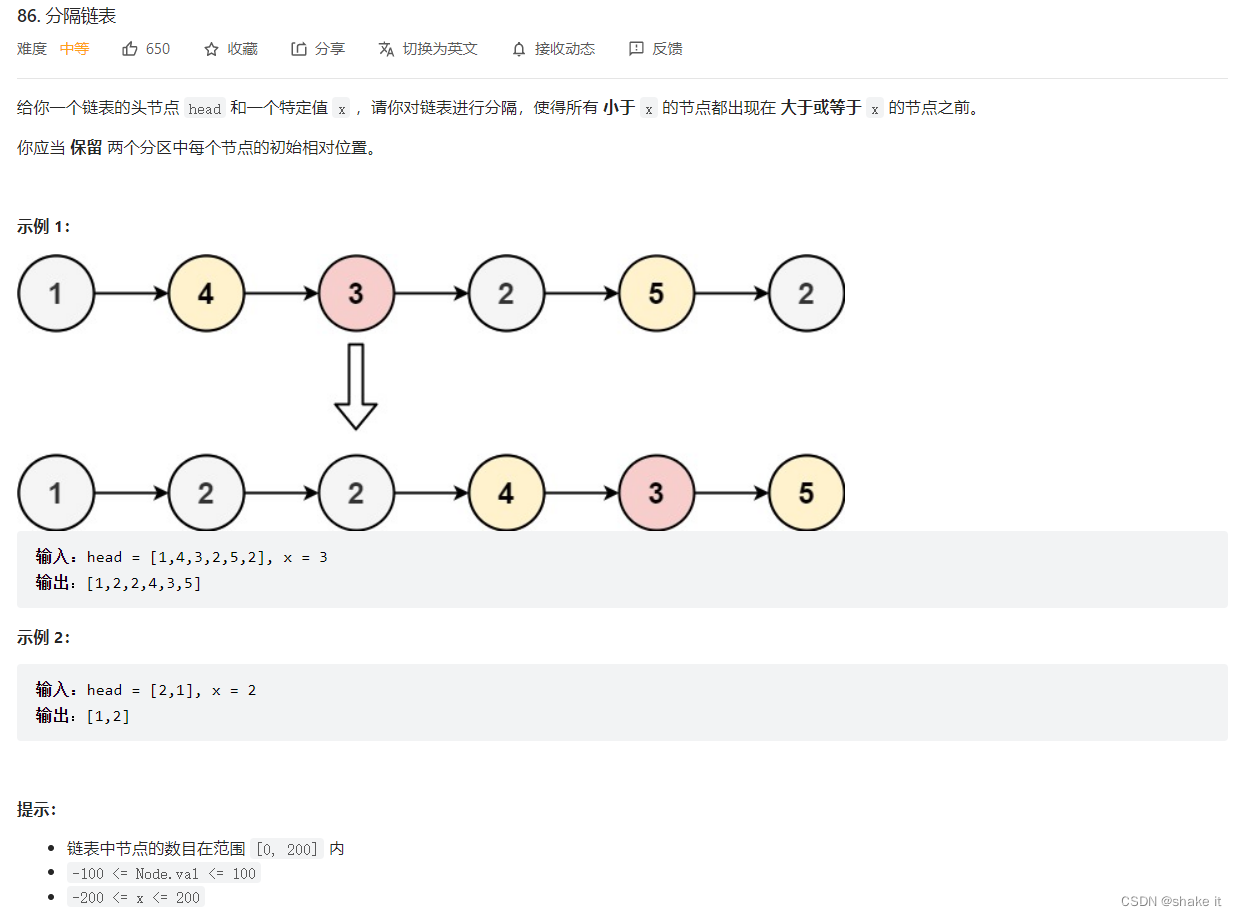
思路:
将这个链表一分为二,一个链表存小于x的值,一个链表存大于等于x的值,最后再把两个链表拼接。
注意:
1.由于直接在原链表上操作,将原链表指针消除,否则连得太乱循环会报错。
2.老问题 返回的时候注意返回的指针指向的是哪一个。
/**
* Definition for singly-linked list.
* function ListNode(val, next) {
* this.val = (val===undefined ? 0 : val)
* this.next = (next===undefined ? null : next)
* }
*/
/**
* @param {ListNode} head
* @param {number} x
* @return {ListNode}
*/
var partition = function(head, x) {
let head1 = new ListNode(0,null),head2 = new ListNode(0,null);
let p1 = head1, p2=head2, p = head;
while(p){
//小值放在p1 大值放在p2
if(p.val<x){
p1.next = p;
p1 = p1.next;
}
else{
p2.next = p;
p2 = p2.next;
}
//由于直接在原链表上操作,将原链表指针消除,否则连得太乱循环会报错
let temp = p.next;
p.next = null;
p = temp;
}
p1.next = head2.next;
//添加虚拟头指针时返回时不要忘了next
//这里第一次写成return p1.next,然而p1已经遍历到第一个链表最后了...
return head1.next;
};
3.合并k个有序链表
困难
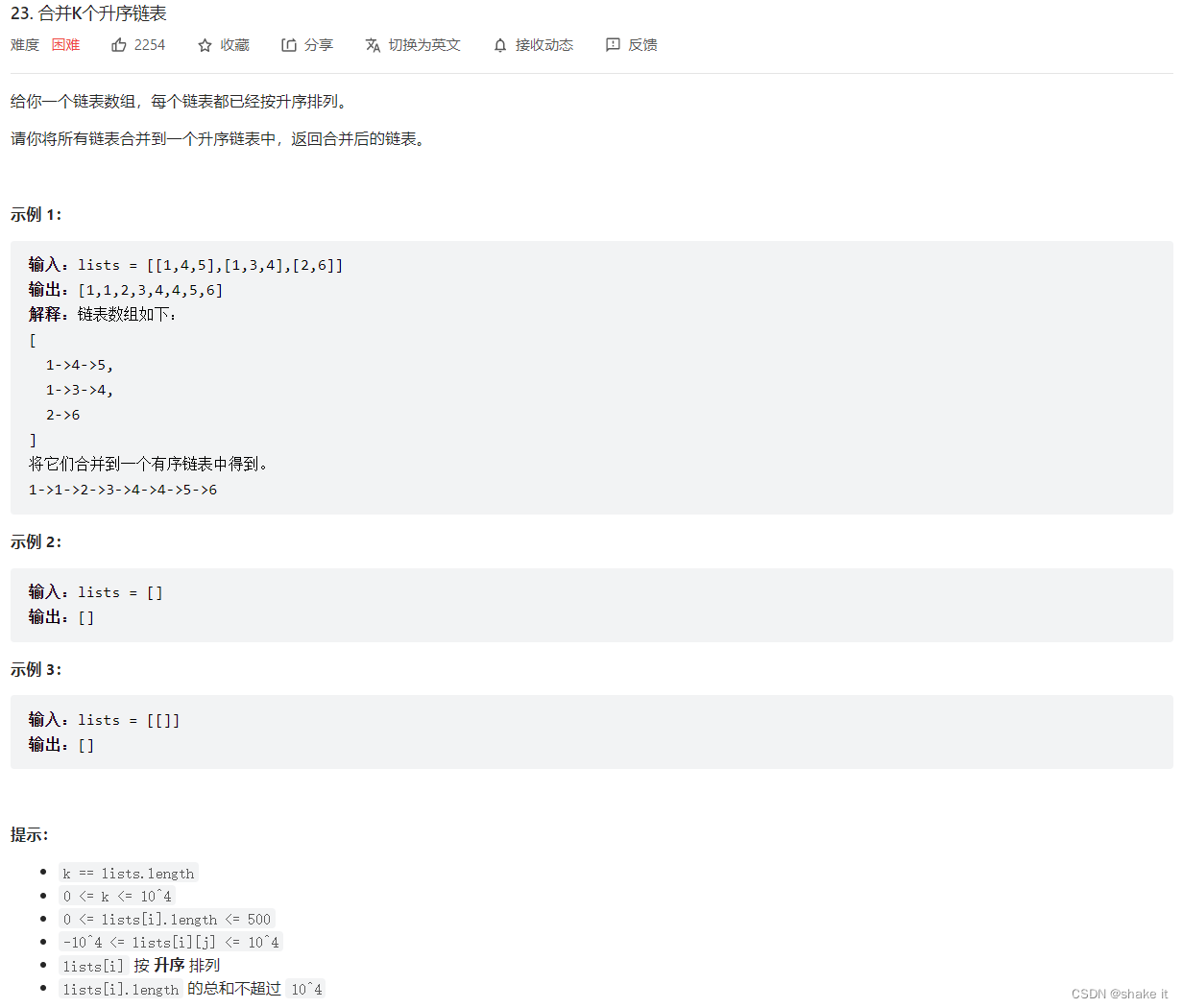
思路:
1.两两归并排序。将k个链表以队列的形式弹出前两个归并,生成的新链表归并入数组末尾,继续弹出前两个排序,直到数组只有一个元素为止。
/**
* Definition for singly-linked list.
* function ListNode(val, next) {
* this.val = (val===undefined ? 0 : val)
* this.next = (next===undefined ? null : next)
* }
*/
/**
* @param {ListNode[]} lists
* @return {ListNode}
*/
var mergeTwoLists = function(listA,listB){
let ret = new ListNode(0,null);
let p1= listA, p2 = listB, cur = ret;
while(p1&&p2){
if(p1.val<p2.val){
cur.next = p1;
p1 = p1.next;
}
else{
cur.next = p2;
p2 = p2.next;
}
cur = cur.next;
}
if(p1==null){
cur.next = p2;
}
if(p2==null){
cur.next = p1;
}
return ret.next;
}
var mergeKLists = function(lists) {
if(lists.length == 0)return null;
while(lists.length > 1){
lists.push(mergeTwoLists(lists.shift(),lists.shift()))
}
return lists[0]
};
2.优先级队列(最小堆)
参考:合并k个有序链表、labuladong
/**
* Definition for singly-linked list.
* function ListNode(val, next) {
* this.val = (val===undefined ? 0 : val)
* this.next = (next===undefined ? null : next)
* }
*/
/**
* @param {ListNode[]} lists
* @return {ListNode}
*/
var mergeKLists = function(lists) {
// 两种思路:优先级队列(二叉堆) 和 JS-API排序
// 首先实现一个优先级队列的数据结构(见下文 class: primaryQueue)
// 声明一个优先级队列
pq = new primaryQueue()
// 构造一个新的链表头节点(第一个节点设置为0,避免空节点等情况)
let result = new ListNode(0)
let p = result
// 插入所有list的头节点
for(list of lists){
if(list)
pq.insert(list)
}
// 将目前队列中的节点进行比较、将最小的追加在原链表后
while(pq.getSize()>1){
const temp = pq.pop()
p.next = temp
p = p.next
// temp 表示 本轮比较中最小的头节点
// temp.next 表示这个链表中的下一个节点
if(temp.next)
pq.insert(temp.next)
}
return result.next
};
// 实现优先级队列
class primaryQueue{
// 定义一个“堆”,存放所有的元素
constructor(){
this.heap = []
this.heap[0] = 0
}
// 交换任意两个节点
swap(index1,index2){
// 存一个别人的写法,有待研究
// [this.heap[i1], this.heap[i2]] = [this.heap[i2], this.heap[i1]];
let temp = this.heap[index1]
this.heap[index1] = this.heap[index2]
this.heap[index2] = temp
}
// 返回父节点索引
getParentIndex(node){
return Math.floor(node/2)
}
// 返回左节点索引
getLeftIndex(node){
return node*2
}
// 返回右节点索引
getRightIndex(node){
return node*2 + 1
}
// 上浮
shiftUp(node){
// 在堆顶之前都while循环着
while(node>1){
let parentNode = this.getParentIndex(node)
if(this.heap[parentNode].val > this.heap[node].val){
this.swap(parentNode,node) // 交换值
// 更新传入的node的索引(随着交换操作上移了)
node = this.getParentIndex(node)
} else
break //堆结构已经得到保证,不需要循环到堆顶了,直接跳出循环
}
}
// 下沉
shiftDown(node){
// 在堆底之前都循环着
while(this.heap[this.getLeftIndex(node)]){
let tempIndex = this.getLeftIndex(node)
let rightIndex = this.getRightIndex(node)
if(this.heap[rightIndex] && this.heap[tempIndex].val > this.heap[rightIndex].val){
tempIndex = rightIndex
}
if(this.heap[node].val<this.heap[tempIndex].val)
break // 如果这个节点比两个子节点都大,退出循环
this.swap(tempIndex,node)
node = tempIndex
}
}
// 插入节点
insert(val){
// 把节点放到堆底,执行上浮操作,让所有节点处于正确位置
this.heap.push(val)
this.shiftUp(this.heap.length-1)
}
// 删除最小的节点
pop(){
// 将原来最小的节点(堆顶)和堆底的节点交换
const top = this.heap[1]
this.swap(1,this.heap.length-1)
this.heap.length-- // 删除交换后的堆底节点,即原来的堆顶节点
this.shiftDown(1) // 对交换到堆定的节点进行下沉操作,保证堆的结构正确
return top
}
// 返回最大的节点
getMin(){
return this.heap[1]
}
// 获取当前堆的大小
getSize(){
return this.heap.length
}
}
4.删除单链表的倒数第 k 个节点
中等
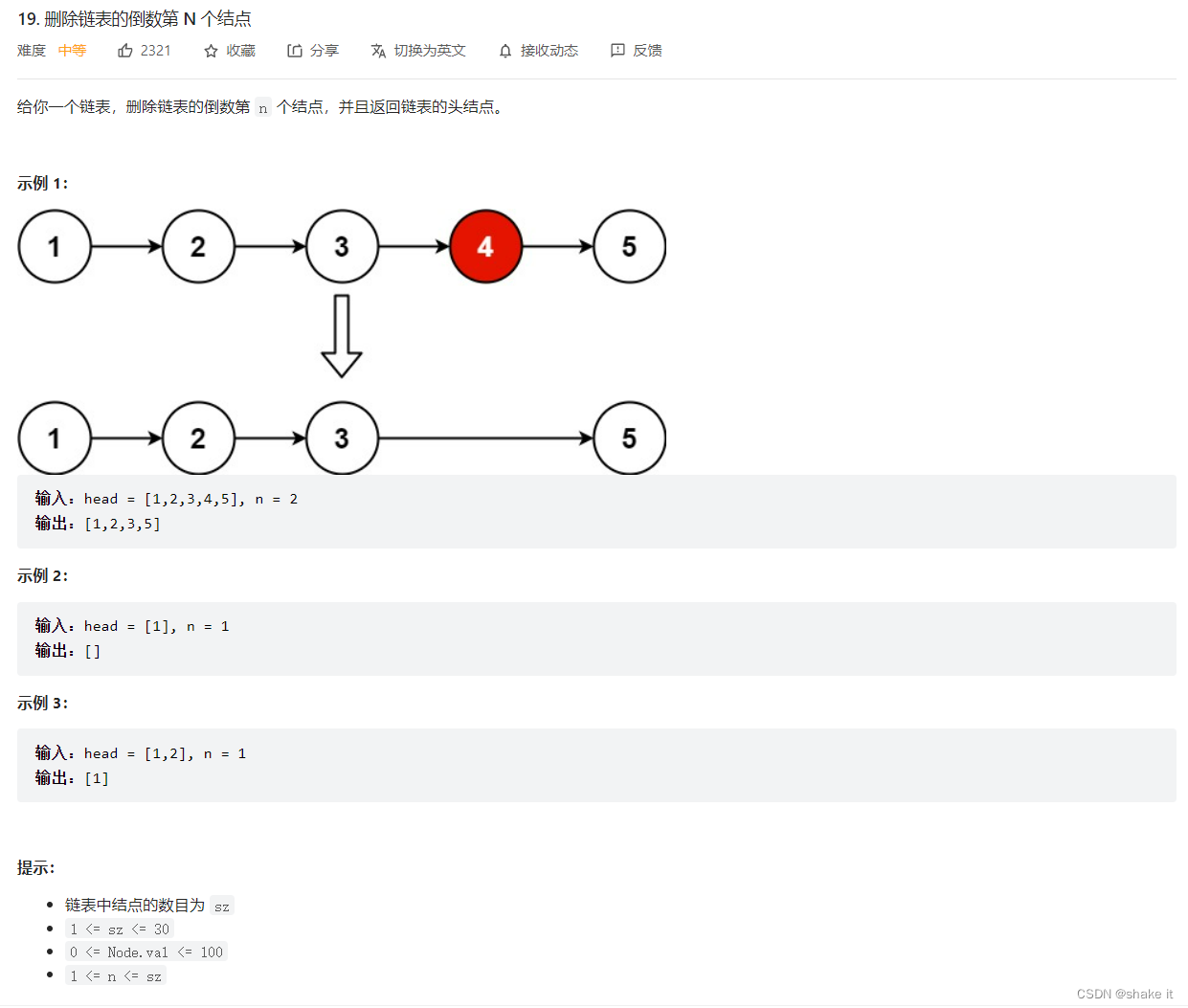
思路:
双指针法。只用遍历一次链表即可。定义fast指针和slow指针,初始值为虚拟头结点。fast首先走n + 1步 ,为什么是n+1呢,因为只有这样同时移动的时候slow才能指向删除节点的上一个节点(方便做删除操作)。fast和slow同时移动,直到fast指向末尾。删除slow指向的下一个节点。
/**
* Definition for singly-linked list.
* function ListNode(val, next) {
* this.val = (val===undefined ? 0 : val)
* this.next = (next===undefined ? null : next)
* }
*/
/**
* @param {ListNode} head
* @param {number} n
* @return {ListNode}
*/
var removeNthFromEnd = function(head, n) {
let ret = new ListNode(0,head);
let slow = fast = ret;
while(n--)fast=fast.next;
while(fast.next!=null){
slow=slow.next;
fast =fast.next;
}
slow.next =slow.next.next;
return ret.next;
};
5.单链表的中点
简单
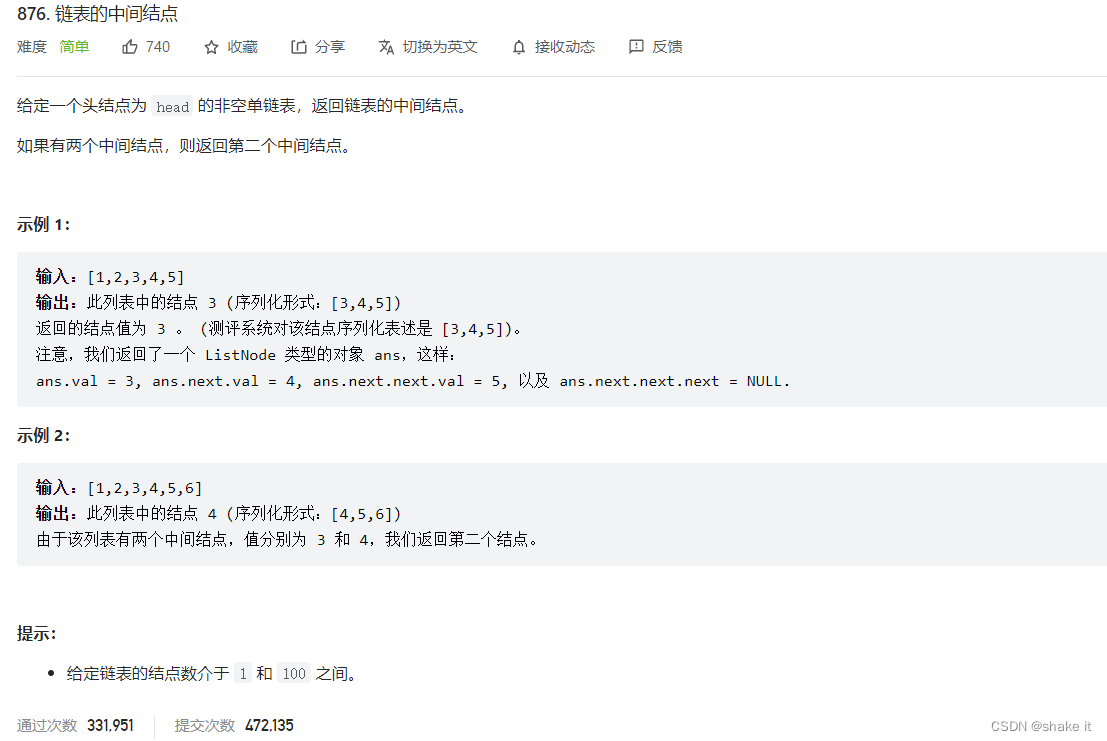
**思路:**让两个指针 slow 和 fast 分别指向链表头结点 head。每当慢指针 slow 前进一步,快指针 fast 就前进两步,这样,当 fast 走到链表末尾时,slow 就指向了链表中点。
/**
* Definition for singly-linked list.
* function ListNode(val, next) {
* this.val = (val===undefined ? 0 : val)
* this.next = (next===undefined ? null : next)
* }
*/
/**
* @param {ListNode} head
* @return {ListNode}
*/
var middleNode = function(head) {
let fast = slow =head;
while(fast&&fast.next){
slow = slow.next;
fast = fast.next.next;
}
return slow;
};
6.环形链表II
中等
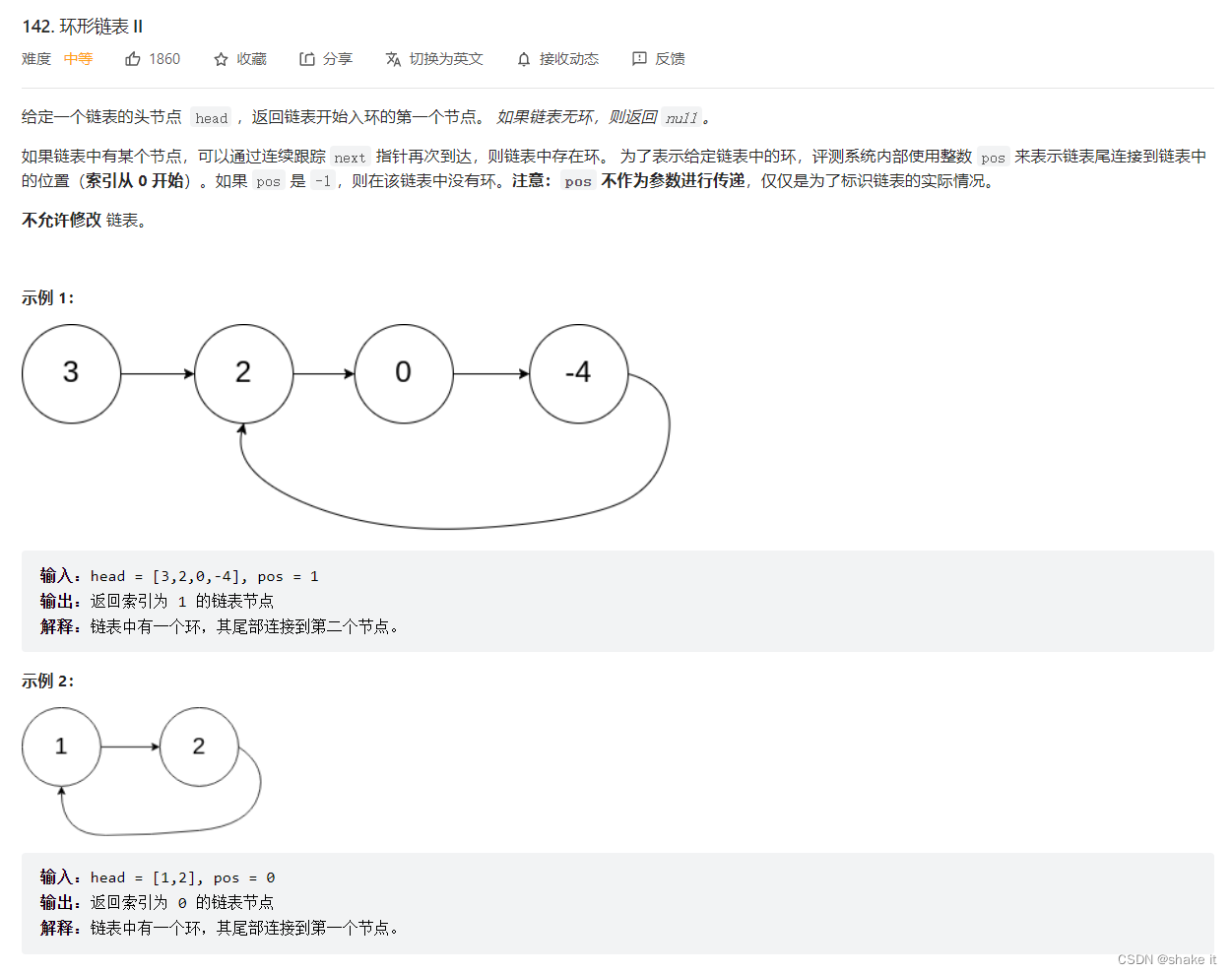
思路:
参考代码随想录环形链表II、labuladong
解决方案也是用快慢指针,每当慢指针 slow 前进一步,快指针 fast 就前进两步。如果 fast 最终遇到空指针,说明链表中没有环;如果 fast 最终和 slow 相遇,那肯定是 fast 超过了 slow 一圈,说明链表中含有环。
假设快慢指针相遇时,慢指针 slow 走了 k 步,那么快指针 fast 一定走了 2k 步。fast 一定比 slow 多走了 k 步,这多走的 k 步其实就是 fast 指针在环里转圈圈,所以 k 的值就是环长度的「整数倍」。假设相遇点距环的起点的距离为 m,那么结合上图的 slow 指针,环的起点距头结点 head 的距离为 k - m,也就是说如果从 head 前进 k - m 步就能到达环起点。巧的是,如果从相遇点继续前进 k - m 步,也恰好到达环起点。因为结合上图的 fast 指针,从相遇点开始走k步可以转回到相遇点,那走 k - m 步肯定就走到环起点了。所以,只要我们把快慢指针中的任一个重新指向 head,然后两个指针同速前进,k - m 步后一定会相遇,相遇之处就是环的起点了。
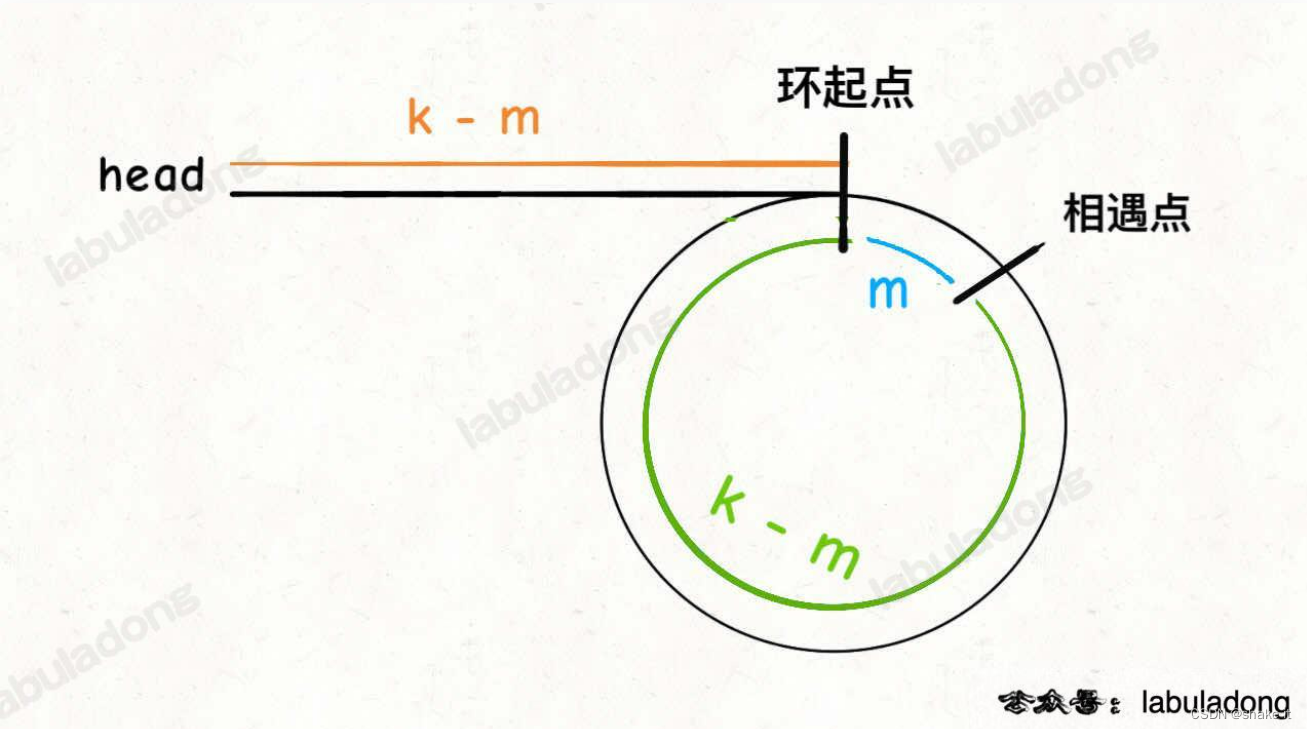
/**
* Definition for singly-linked list.
* function ListNode(val) {
* this.val = val;
* this.next = null;
* }
*/
/**
* @param {ListNode} head
* @return {ListNode}
*/
var detectCycle = function(head) {
let slow = fast = head;
if(!fast||!fast.next)return null;
while(fast&&fast.next){
slow = slow.next;
fast = fast.next.next;
if(slow==fast){
slow = head;
while(slow!=fast){
slow =slow.next;
fast = fast.next;
}
return slow;
}
}
return null;
};
7.两个链表是否相交
简单

思路:
交点不是数值相等,而是指针相等。
1.如果用两个指针 p1 和 p2 分别在两条链表上前进,并不能同时走到公共节点,也就无法得到相交节点 c1。解决这个问题的关键是,通过某些方式,让 p1 和 p2 能够同时到达相交节点 c1。所以,我们可以让 p1 遍历完链表 A 之后开始遍历链表 B,让 p2 遍历完链表 B 之后开始遍历链表 A,这样相当于「逻辑上」两条链表接在了一起。如果这样进行拼接,就可以让 p1 和 p2 同时进入公共部分,也就是同时到达相交节点 c1。
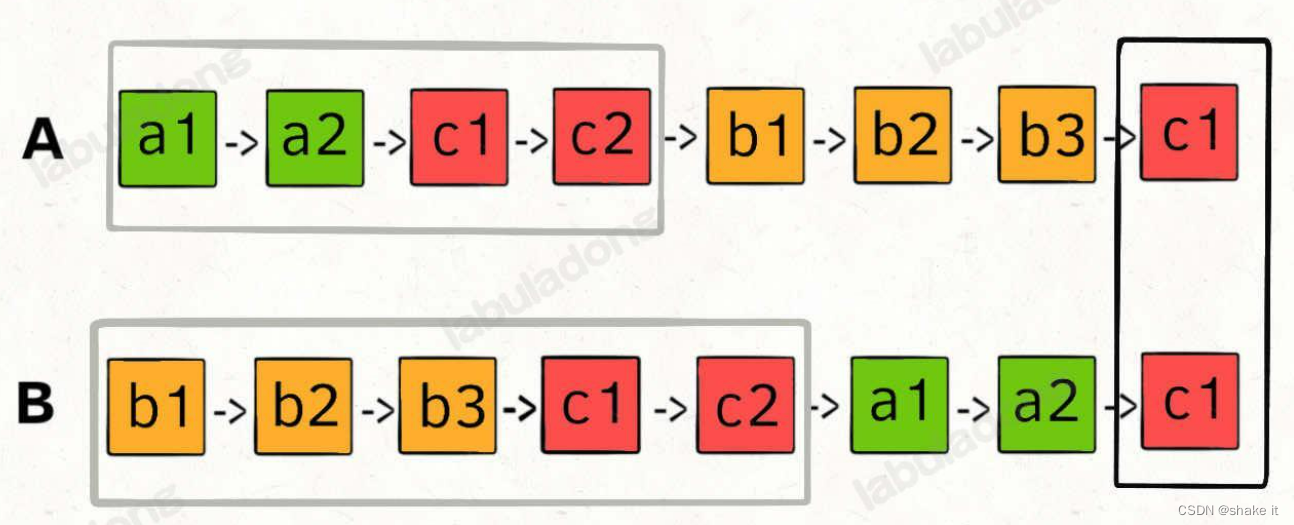
2.curA指向链表A的头结点,curB指向链表B的头结点。求出两个链表的长度,并求出两个链表长度的差值,然后让curA移动到和curB 末尾对齐的位置, 此时就可以比较curA和curB是否相同,如果不相同,同时向后移动curA和curB,如果遇到curA == curB,则找到交点。否则循环退出返回空指针。
//思路1
/**
* Definition for singly-linked list.
* function ListNode(val) {
* this.val = val;
* this.next = null;
* }
*/
/**
* @param {ListNode} headA
* @param {ListNode} headB
* @return {ListNode}
*/
var getIntersectionNode = function(headA, headB) {
let p1 = headA, p2 = headB;
while(p1!=p2){
p1=p1.next;
p2=p2.next;
if(p1==null&&p2==null)return null;
if(p1==null){
p1 = headB;
}
if(p2== null){
p2 = headA;
}
}
return p1;
};
//思路2
/**
* Definition for singly-linked list.
* function ListNode(val) {
* this.val = val;
* this.next = null;
* }
*/
/**
* @param {ListNode} headA
* @param {ListNode} headB
* @return {ListNode}
*/
var getLen = function(head){
let cur = head, len = 0;
while(cur){
len++;
cur=cur.next;
}
return len;
}
var getIntersectionNode = function(headA, headB) {
let curA = headA, curB = headB;
let lenA = getLen(headA), lenB = getLen(headB);
if(lenA < lenB){
//es6特性 交换
[curA, curB] = [curB, curA];
[lenA, lenB] = [lenB, lenA];
}
let gap = lenA - lenB;
while(gap--){
curA=curA.next;
}
while(curA&&curA!=curB){
curA = curA.next;
curB = curB.next;
}
return curA;
};
8.反转链表
简单
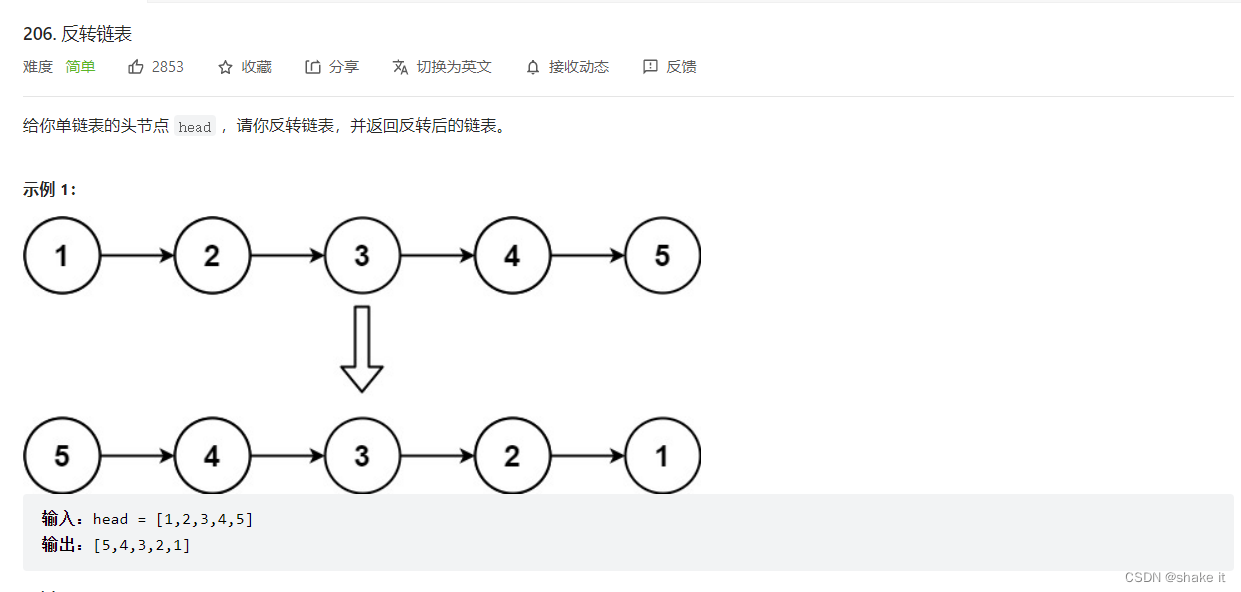
思路:
1.首先定义一个cur指针,指向头结点,再定义一个pre指针,初始化为null。然后就要开始反转了,首先要把 cur->next 节点用tmp指针保存一下,也就是保存一下这个节点。为什么要保存一下这个节点呢,因为接下来要改变 cur->next 的指向了,将cur->next 指向pre ,此时已经反转了第一个节点了。接下来,就是循环走如下代码逻辑了,继续移动pre和cur指针。最后,cur 指针已经指向了null,循环结束,链表也反转完毕了。 此时我们return pre指针就可以了,pre指针就指向了新的头结点。
2.递归的简洁使用。参考labuladong
/**
* Definition for singly-linked list.
* function ListNode(val, next) {
* this.val = (val===undefined ? 0 : val)
* this.next = (next===undefined ? null : next)
* }
*/
/**
* @param {ListNode} head
* @return {ListNode}
*/
var reverseList = function(head) {
return reverse(null, head);
};
var reverse = function(pre,head){
if(!head) return pre;
let temp = head.next;
head.next = pre;
return reverse(head, temp);
}
//递归2
var reverseList = function(head) {
if (head == null || head.next == null) return head; // 递归终止条件
let last = reverseList(head.next); // 递归反转后续节点
head.next.next = head; // 将当前节点设置为后续节点的后续节点
head.next = null; // 将当前节点的后续节点设置为空
return last; // 返回反转后的链表
}
9.反转链表前 N 个节点
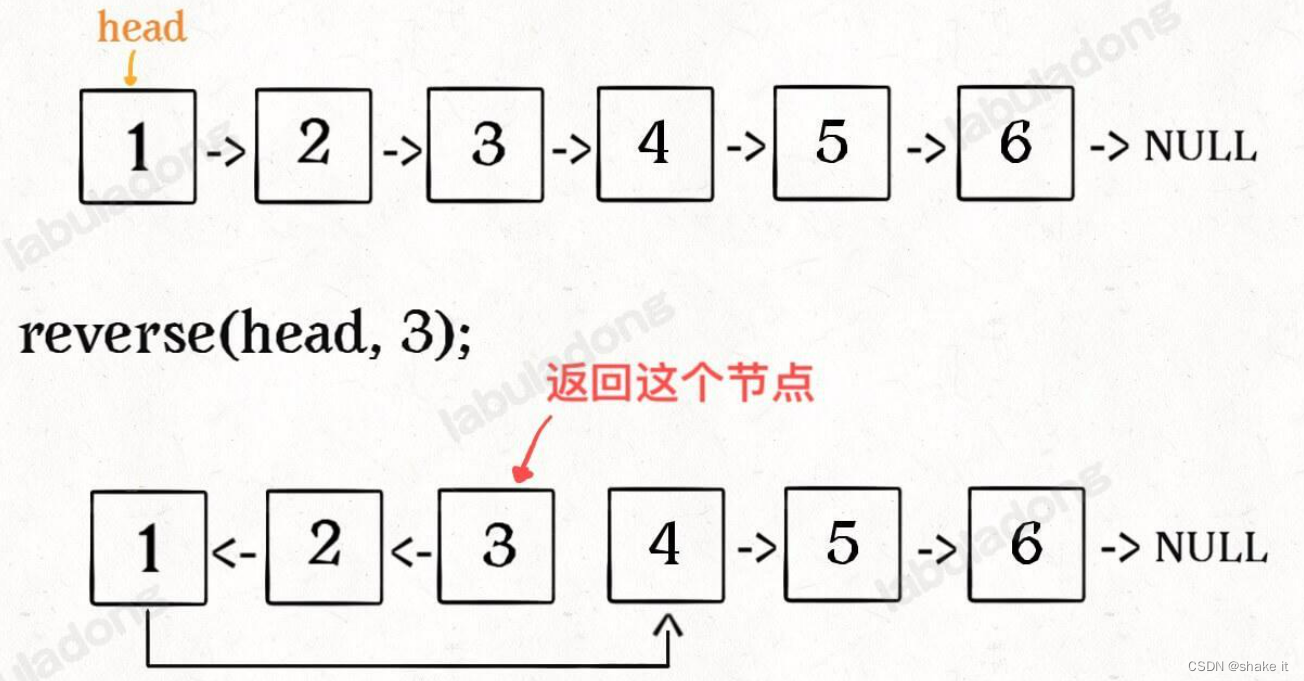
思路:
base case 变为 n == 1,反转一个元素,就是它本身,同时要记录后驱节点。刚才直接把 head.next 设置为 null,因为整个链表反转后原来的 head 变成了整个链表的最后一个节点。但现在 head 节点在递归反转之后不一定是最后一个节点了,所以要记录后驱 follower(第 n + 1 个节点),反转之后将 head 连接上。
let follower = null;
var reverseListTopN = function(head,n){
if(n==1){
follower = head.next;
return head;
}
let last = reverseListTopN(head.next,n-1);
head.next.next = head;
head.next = follower;
return last;
}
10.反转链表一部分
中等
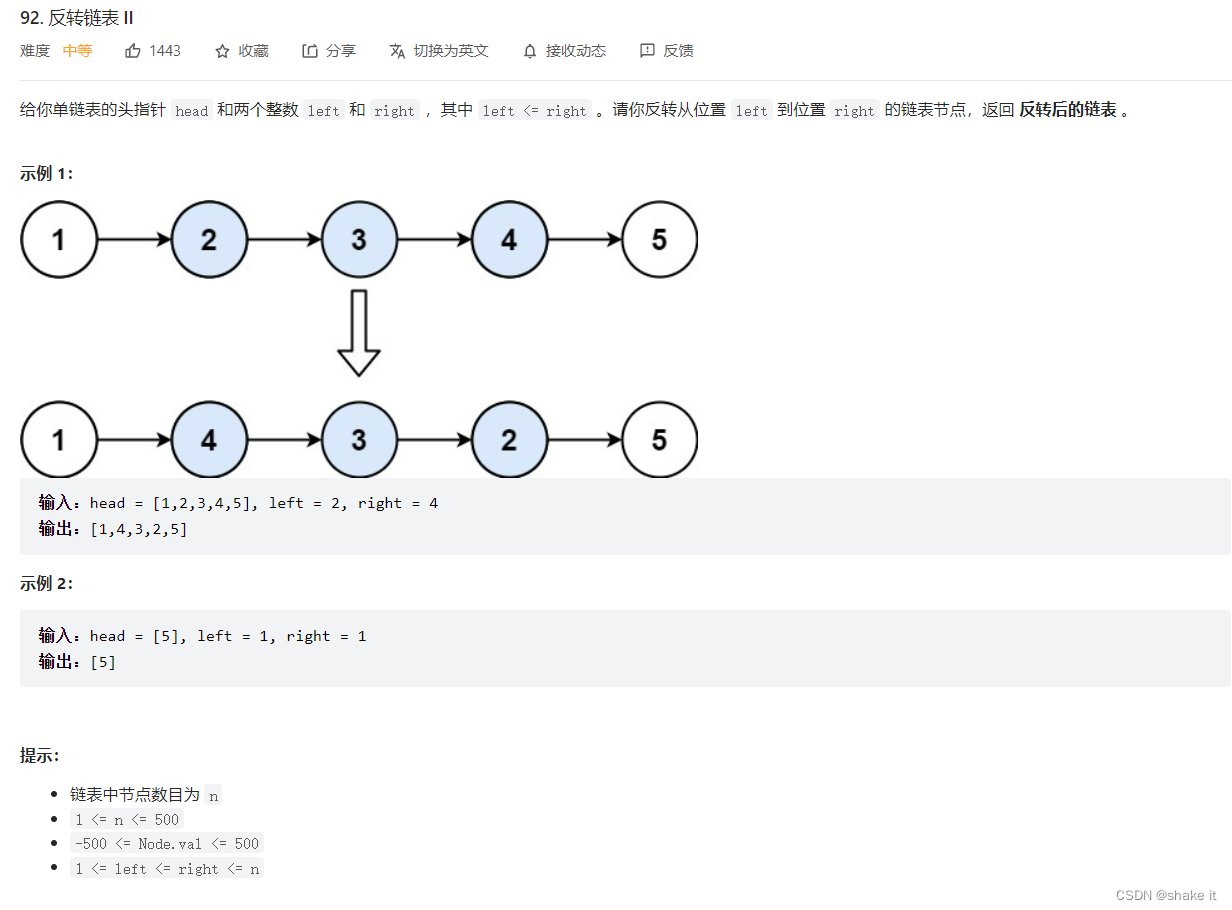
思路:
1.递归。如果 m == 1,就相当于反转链表开头的 n 个元素。当 m != 1,如果把 head 的索引视为 1,那么是想从第 m 个元素开始反转;如果把 head.next 的索引视为 1 ,那么相对于 head.next,反转的区间应该是从第 m - 1 个元素开始的,反转区间为[m-1,n-1]。
2.迭代。
/**
* Definition for singly-linked list.
* function ListNode(val, next) {
* this.val = (val===undefined ? 0 : val)
* this.next = (next===undefined ? null : next)
* }
*/
/**
* @param {ListNode} head
* @param {number} left
* @param {number} right
* @return {ListNode}
*/
let follower = null;
var reverseTopN = function(head,n){
if(n==1){
follower = head.next;
return head;
}
let last = reverseTopN(head.next, n-1);
head.next.next = head;
head.next = follower;
return last;
}
var reverseBetween = function(head, left, right) {
if(left == 1){
return reverseTopN(head, right);
}
head.next = reverseBetween(head.next, left-1, right-1);
return head;
};
//迭代
/**
* Definition for singly-linked list.
* function ListNode(val, next) {
* this.val = (val===undefined ? 0 : val)
* this.next = (next===undefined ? null : next)
* }
*/
/**
* @param {ListNode} head
* @param {number} left
* @param {number} right
* @return {ListNode}
*/
var reverseBetween = function(head, left, right) {
let ret = new ListNode(0,head);
let pre = ret, cur = head;
let prev= ret;
for(let i = 1; i<left+1; i++){
pre = pre.next;
cur = cur.next;
if(i==left-1)prev=pre;
}
// console.log(pre);
// console.log(cur);
// console.log(prev);
let last = pre;
let n = right-left;
// console.log(last);
while(n--){
let temp = cur.next;
cur.next = pre;
pre = cur;
cur = temp;
}
prev.next = pre;
// console.log(last);
last.next = cur;
// console.log(pre);
// console.log(cur);
return ret.next;
};
10. K 个一组翻转链表
困难
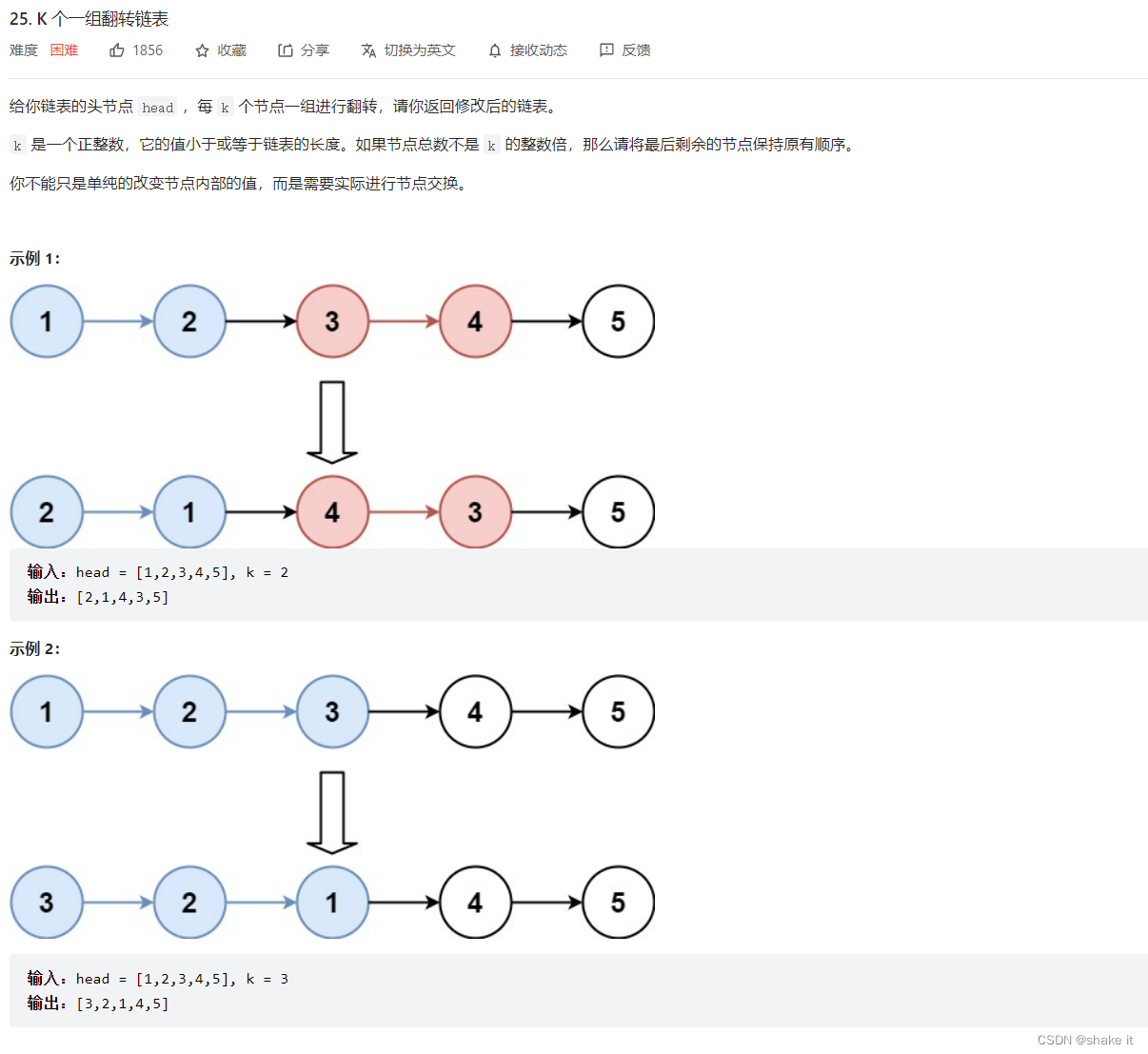
思路:
递归。先反转以 head 开头的 k 个元素。将第 k + 1 个元素作为 head 递归调用 reverseKGroup 函数。将上述两个过程的结果连接起来。如果最后的元素不足 k 个,就保持不变。这就是 base case。「反转以 a 为头结点的链表」其实就是「反转 a 到 null 之间的结点」,「反转 a 到 b 之间的结点」只要更改函数签名,并把上面的代码中 null 改成 b 即可。注意 reverse 函数是反转区间 [a, b)。
/**
* Definition for singly-linked list.
* function ListNode(val, next) {
* this.val = (val===undefined ? 0 : val)
* this.next = (next===undefined ? null : next)
* }
*/
/**
* @param {ListNode} head
* @param {number} k
* @return {ListNode}
*/
var reverseKGroup = function(head, k) {
if(head==null)return null;
var reverse = function(head,tail){
let pre = null, cur = head;
// while 终止的条件改为tail
while(cur!=tail&&cur){
let temp = cur.next;
cur.next = pre;
pre = cur;
cur = temp;
}
return pre;
}
let a = head, b = head;
//左闭右开 区间 [a, b) 包含 k 个待反转元素
for(let i = 0; i<k; i++){
// 不足 k 个,不需要反转,base case
if (b==null) return a;
b=b.next;
}
let newHead = reverse(a,b);
// 递归反转后续链表并连接起来
a.next = reverseKGroup(b,k);
return newHead;
};
11.回文链表
简单
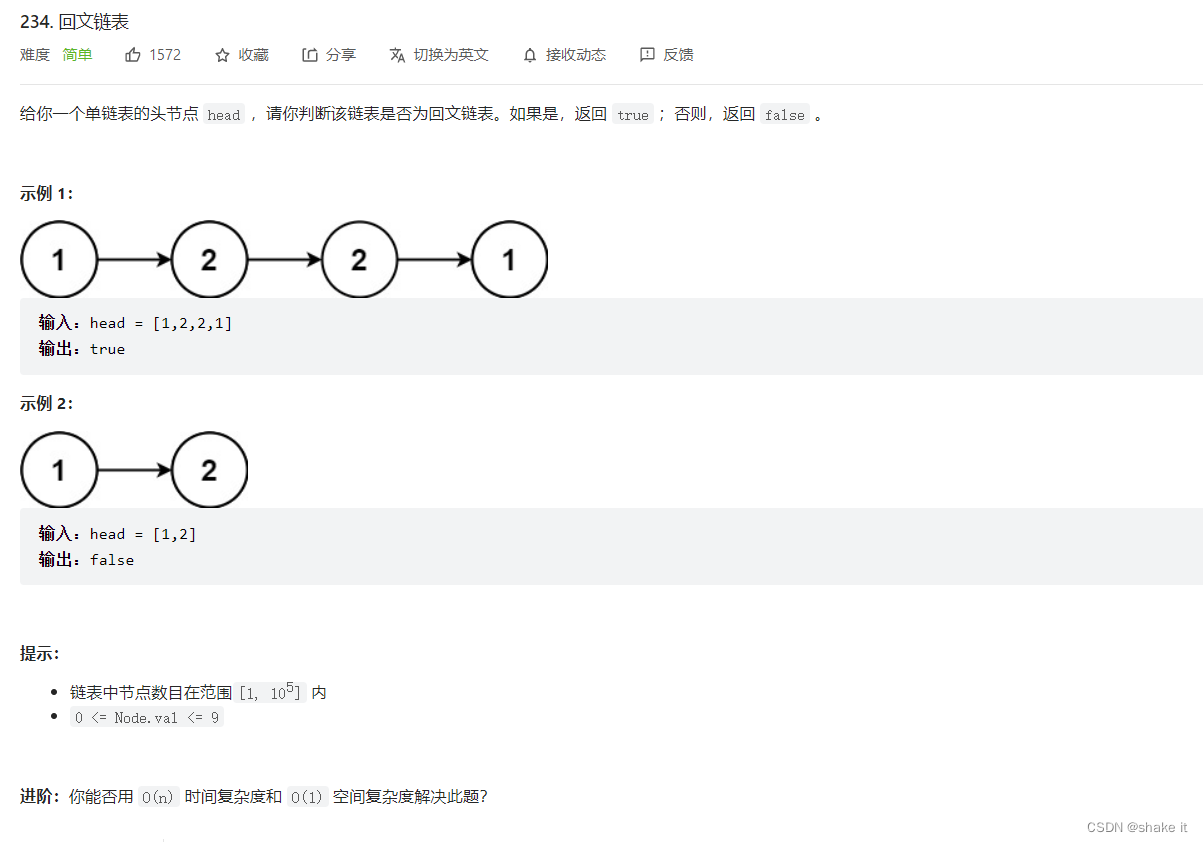
思路:
回文串就是正着读和反着读都一样的字符串。
1.原始链表反转存入一条新的链表,然后比较这两条链表是否相同。
2.利用二叉树后序遍历。
3.翻转后半部分链表,并进行回文串的判断。
定义slow,fast两个指针,slow每次走一步,fast每次走两步。当fast走到尾结点或者null时,slow到达中点。

如果fast指针没有指向null,说明链表长度为奇数,slow还要再前进一步。
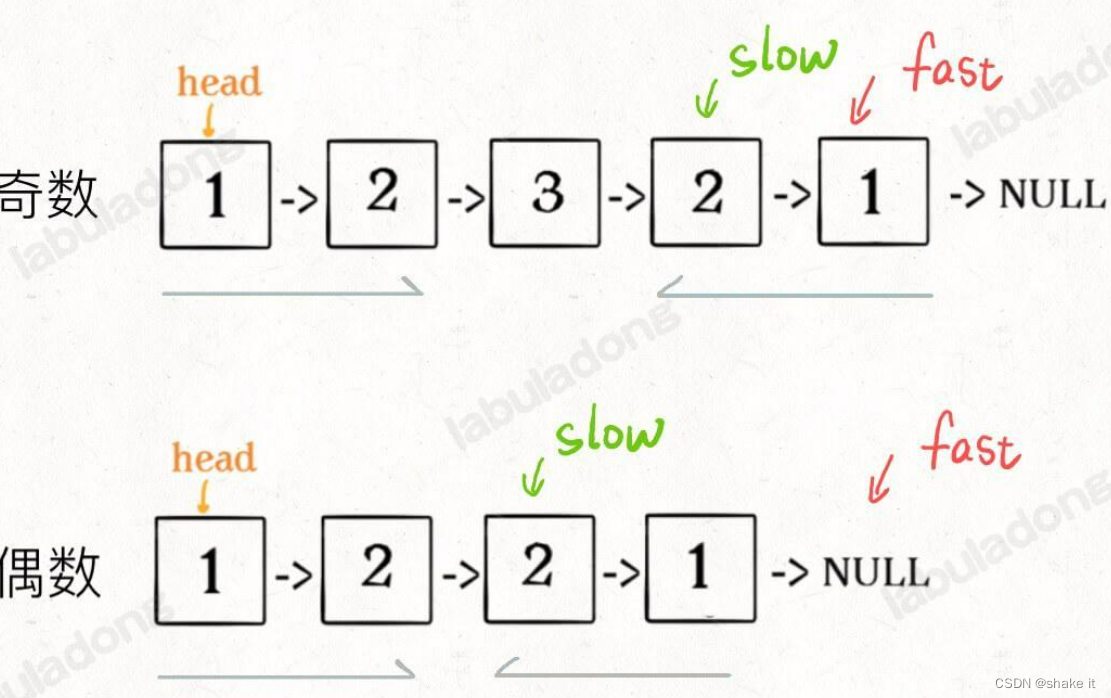
从slow开始反转后面的链表,现在就可以开始比较回文串了。
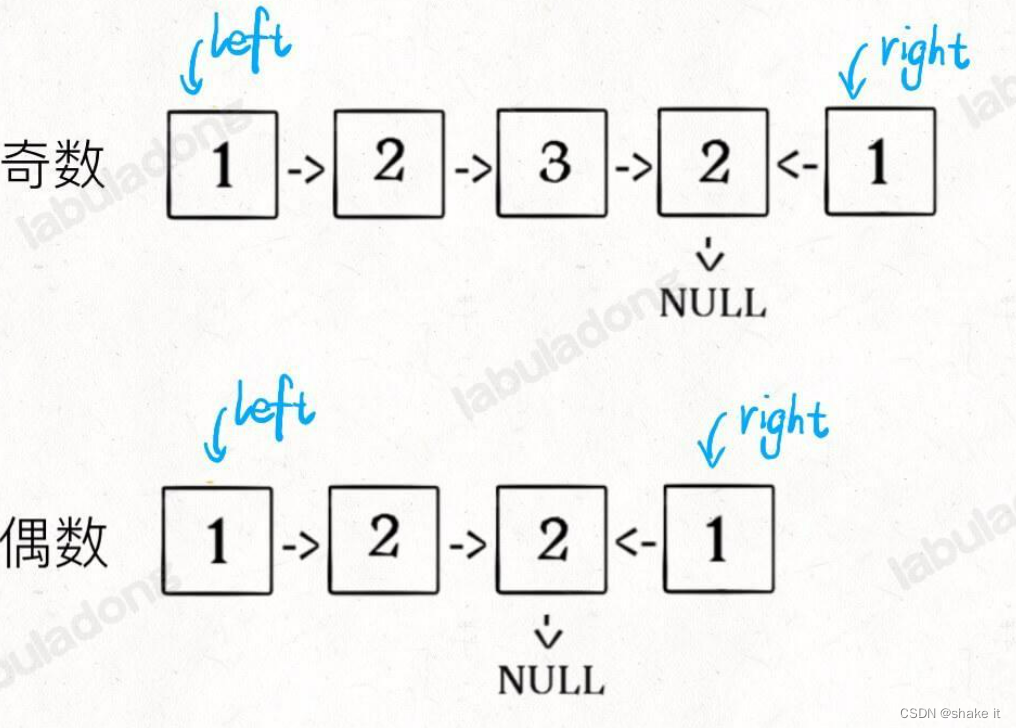
如果不想改变原有链表结构,只需:
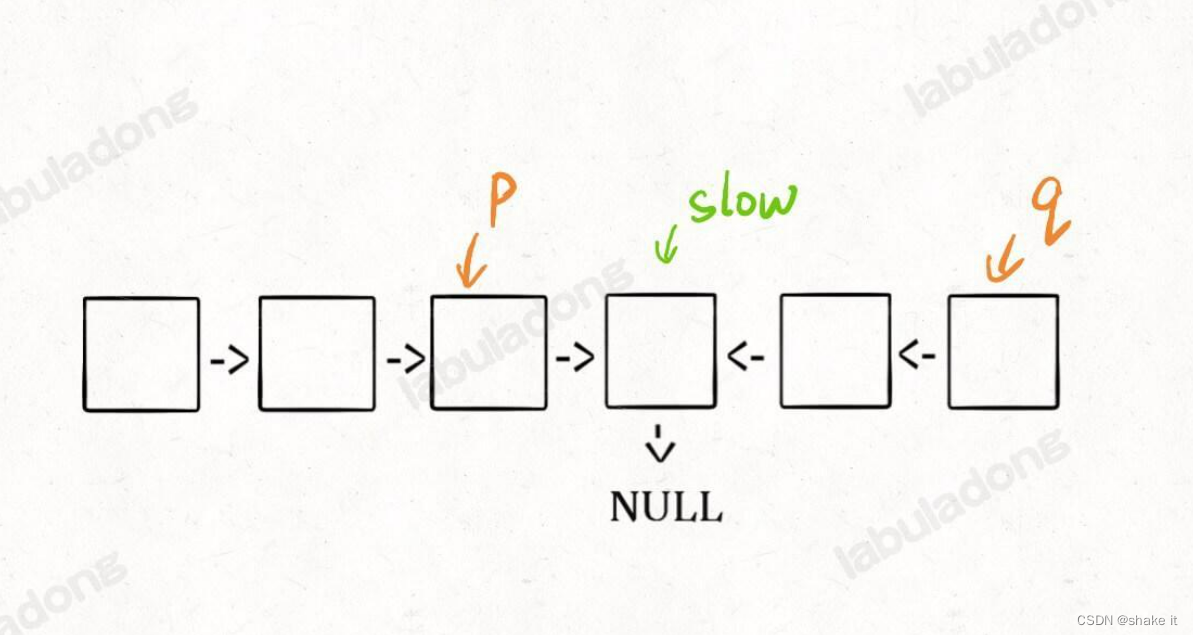
p.next = reverse(q);
第三种思路解法如下:
/**
* Definition for singly-linked list.
* function ListNode(val, next) {
* this.val = (val===undefined ? 0 : val)
* this.next = (next===undefined ? null : next)
* }
*/
/**
* @param {ListNode} head
* @return {boolean}
*/
var isPalindrome = function(head) {
if(!head&&head.next == null) return true;
var reverse = function(head){
let pre = null, cur = head, temp = null;
while(cur){
temp = cur.next;
cur.next = pre;
pre = cur;
cur = temp;
}
return pre;
}
let slow = fast = head;
while(fast&&fast.next){
slow = slow.next;
fast = fast.next.next;
}
let p = slow;
//如果是奇数串 找到中点后slow还要往后走一步
if(fast!=null){
slow = slow.next;
}
let left = head;
let q = reverse(slow);
let right = q;
while(right){
if(left.val !== right.val){
return false;
}
left = left.next;
right = right.next;
}
//如果不想破坏原链表的结构 可加这一句
p.next = reverse(q);
return true;
};
12.两两交换链表中的节点
中等
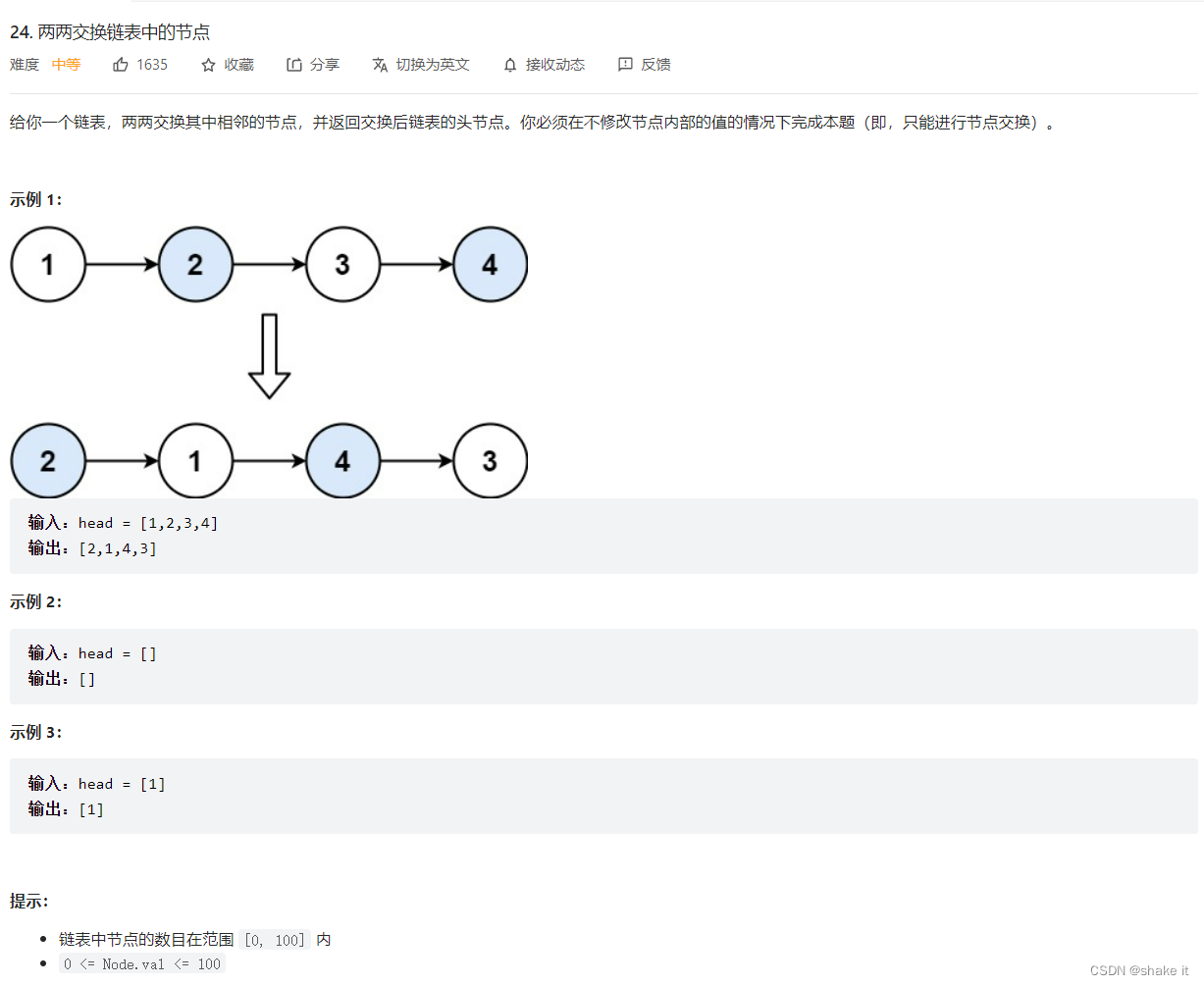
思路:
双指针。使用虚拟头节点处理。
/**
* Definition for singly-linked list.
* function ListNode(val, next) {
* this.val = (val===undefined ? 0 : val)
* this.next = (next===undefined ? null : next)
* }
*/
/**
* @param {ListNode} head
* @return {ListNode}
*/
var swapPairs = function(head) {
let ret = new ListNode(0,head), temp=ret;
while(temp.next&&temp.next.next){
let pre = temp.next;
let cur = temp.next.next;
pre.next = cur.next;
cur.next = pre;
temp.next = cur;
temp = pre;
}
return ret.next;
};
13.设计链表
中等
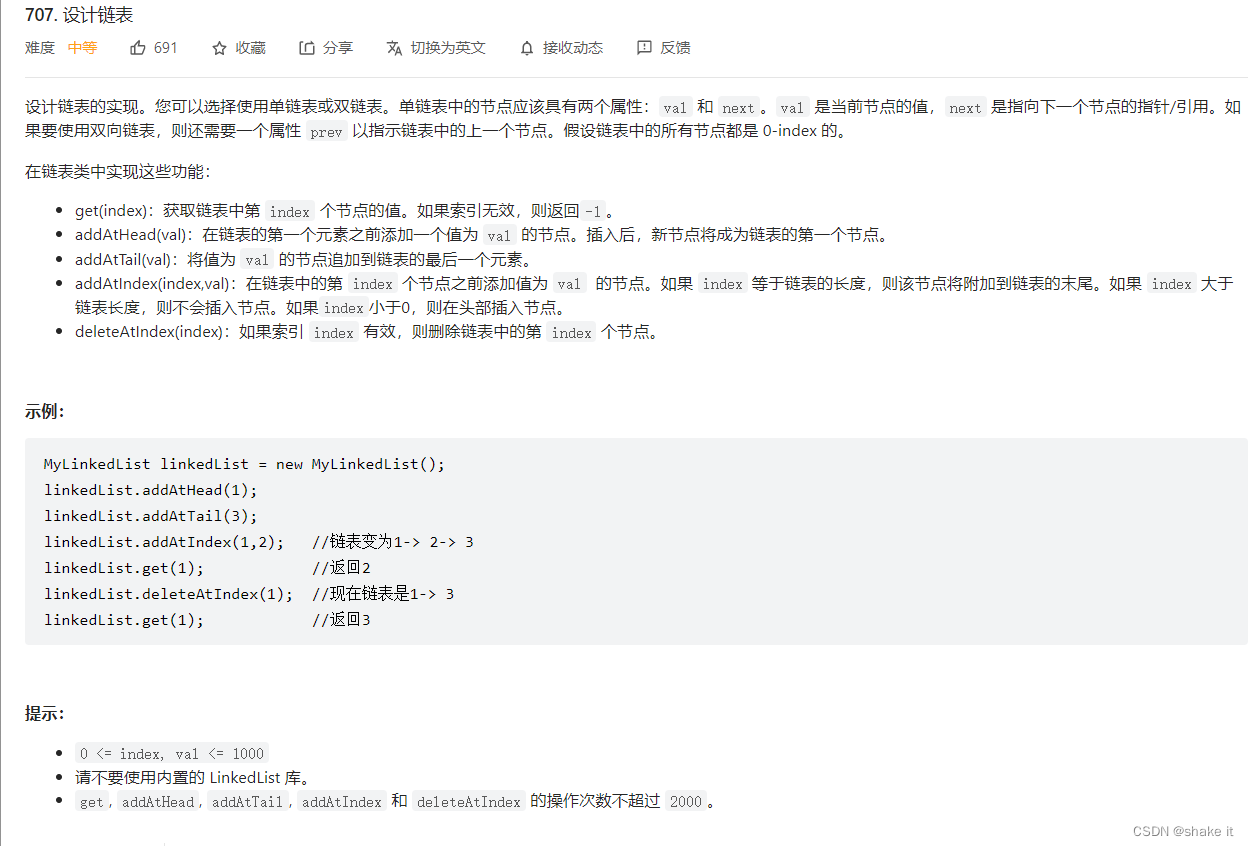
class LinkNode{
constructor(val,next){
this.val=val;
this.next=next;
}
}
var MyLinkedList = function() {
this._size = 0;
this._head = null;
this._tail = null;
};
MyLinkedList.prototype.getNode = function(index){
if(index<0 || index>=this._size) return null;
if(index==0) return this._head;
let cur = new LinkNode(0,this._head);
for(let i = 0; i<=index;i++){
cur = cur.next;
}
return cur;
}
/**
* @param {number} index
* @return {number}
*/
MyLinkedList.prototype.get = function(index) {
if(!this.getNode(index)) return -1;
let node = this.getNode(index);
return node.val;
};
/**
* @param {number} val
* @return {void}
*/
MyLinkedList.prototype.addAtHead = function(val) {
let node = new LinkNode(val,this._head);
this._head = node;
if(!this._tail){
this._tail = node;
}
this._size++;
return;
};
/**
* @param {number} val
* @return {void}
*/
MyLinkedList.prototype.addAtTail = function(val) {
let node = new LinkNode(val,null);
if(this._tail){
this._tail.next = node;
this._tail = node;
this._size++;
return;
}
this._tail = node;
this._head = node;
this._size++;
return;
};
/**
* @param {number} index
* @param {number} val
* @return {void}
*/
MyLinkedList.prototype.addAtIndex = function(index, val) {
if(index>this._size) return;
if(index<=0){
this.addAtHead(val);
return;
}
if(index==this._size){
this.addAtTail(val);
return;
}
let node = new LinkNode(val, null);
let last = this.getNode(index-1);
node.next = last.next;
last.next = node;
this._size++;
return;
};
/**
* @param {number} index
* @return {void}
*/
MyLinkedList.prototype.deleteAtIndex = function(index) {
if(index>=this._size || index<0) return;
if(index==0){
this._head = this._head.next;
if(this._size==1){
this._tail=null;
}
this._size--;
return;
}
let last = this.getNode(index-1)
last.next = last.next.next;
if(index==this._size-1){
this._tail = last;
}
this._size--;
return;
};
/**
* Your MyLinkedList object will be instantiated and called as such:
* var obj = new MyLinkedList()
* var param_1 = obj.get(index)
* obj.addAtHead(val)
* obj.addAtTail(val)
* obj.addAtIndex(index,val)
* obj.deleteAtIndex(index)
*/
14.移除链表元素
简单
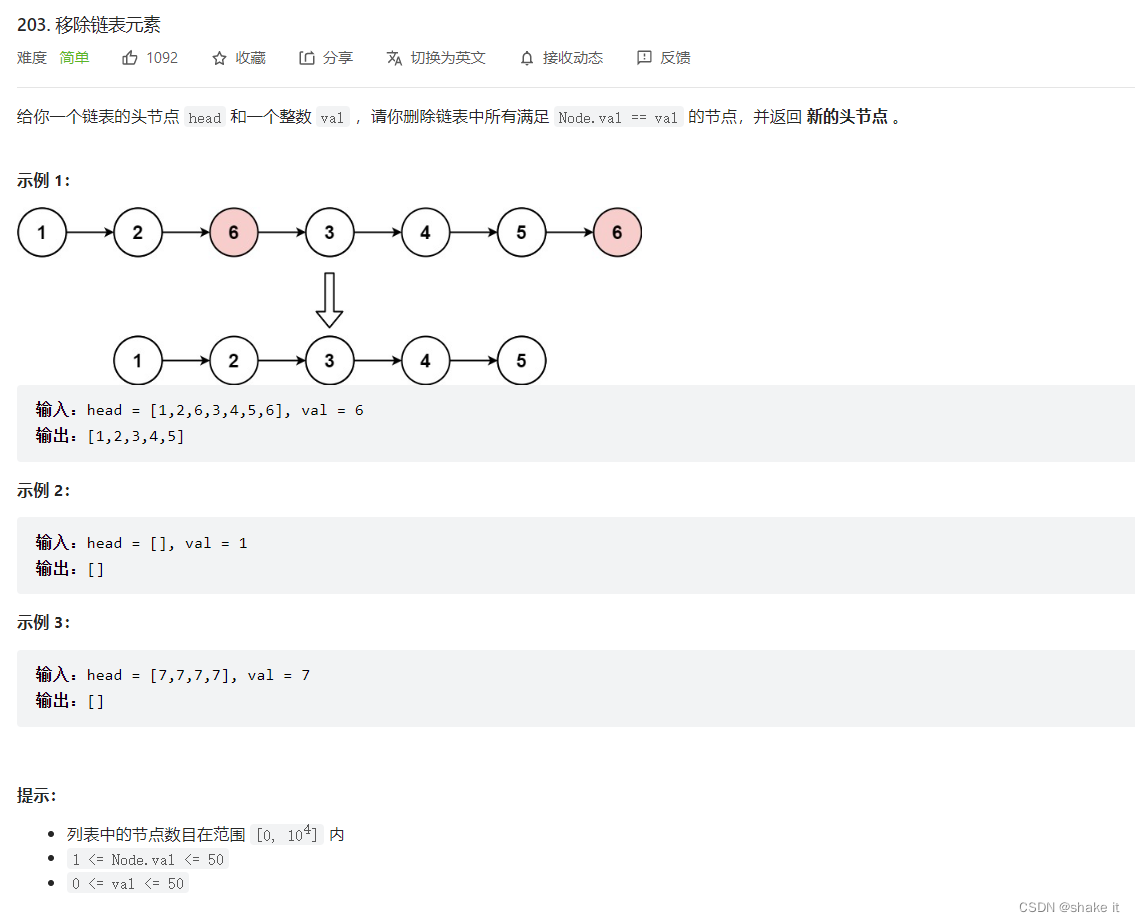
/**
* Definition for singly-linked list.
* function ListNode(val, next) {
* this.val = (val===undefined ? 0 : val)
* this.next = (next===undefined ? null : next)
* }
*/
/**
* @param {ListNode} head
* @param {number} val
* @return {ListNode}
*/
var removeElements = function(head, val) {
const ret = new ListNode(0,head);
let cur = ret;
while(cur.next){
if(cur.next.val === val){
cur.next = cur.next.next;
continue;
}
cur = cur.next;
}
return ret.next;
};





















 212
212











 被折叠的 条评论
为什么被折叠?
被折叠的 条评论
为什么被折叠?








